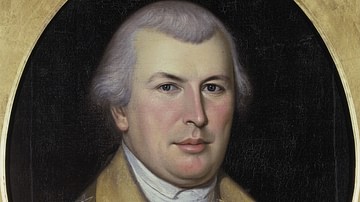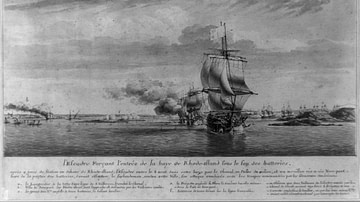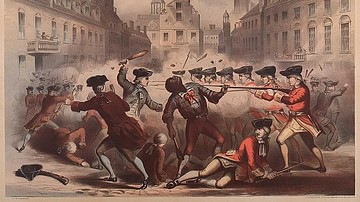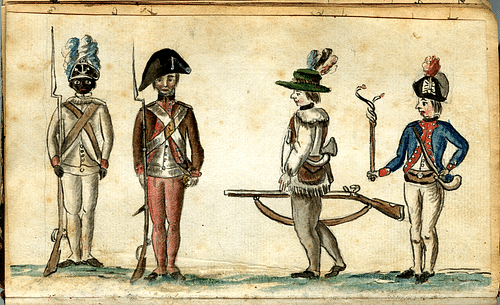
The 1st Rhode Island Regiment, also known as Varnum's Regiment or the Black Regiment, was a regiment of the Continental Army during the American Revolutionary War (1775-1783). It was notable for being the first American military unit to consist mainly of non-white soldiers, many of whom were enslaved Black or Native American men serving to win their freedom.
At the outset of the war, General George Washington, commander-in-chief of the American forces, restricted Black men, enslaved or free, from enlisting in the Continental Army. This decree was not strictly enforced, however, and most Continental regiments recruited Black and Native American men to replenish their ranks. Ultimately, 4% of the soldiers who served in the Continental Army would be Black, but no majority-Black regiment existed until 1778 when the state of Rhode Island, struggling to meet the recruitment quotas set by the Second Continental Congress, decided to allow Black and Native American men to enlist in the 1st Rhode Island Regiment. Even enslaved men were allowed to enlist and were promised their freedom in return for their military service; the Rhode Island Assembly agreed to pay slave owners the market value of each slave that enlisted. Ultimately, 140 of the regiment's 225 soldiers were Black or Native American men.
Led by a white officer, Colonel Christopher Greene, the regiment saw action in several battles, earning distinction at the Battle of Red Bank (22 October 1777), Battle of Rhode Island (29 August 1778), and Battle of Pines Bridge (14 May 1781), where Colonel Greene was killed. After participating in the final major battle of the war at Yorktown, the regiment was moved to Saratoga, where it was disbanded at the end of the war. The Black soldiers, though granted their freedom, were often unable to secure the back pay owed to them by Congress and had to petition for the money they had been promised, leading the Rhode Island Assembly to pass an act in 1785 that required townships to care for Black or Indigenous veterans who could not financially support themselves.
The Regiment's Origins
On 8 May 1775, only weeks after the first shots were fired at the Battles of Lexington and Concord, the 1st Rhode Island regiment was organized. Consisting of eight companies of volunteer soldiers from Kent and Kings Counties, it was initially placed under the command of Colonel James Mitchell Varnum, a prominent Rhode Island lawyer. Nicknamed ‘Varnum's Regiment' after its commander, the 1st Rhode Island marched to Roxbury, Massachusetts, where it was incorporated into the Continental Army and took part in the Siege of Boston (20 April 1775 to 17 March 1776). Only days after the regiment's arrival in Massachusetts, it participated in the Battle of Bunker Hill (17 June 1775). After Boston was reclaimed by Patriot forces, the 1st Rhode Island remained with the Continental Army, serving in the miserable New York and New Jersey Campaign, during which time it saw action at the Battle of Long Island (27 August 1776), Battle of Trenton (26 December 1776), and Battle of Princeton (3 January 1777).
In February 1777, Varnum was promoted to brigadier general, and the command of the 1st Rhode Island was given to Colonel Christopher Greene, a distant cousin of General Nathanael Greene, Washington's trusted second-in-command. Colonel Greene had spent eight months as a British prisoner-of-war before being released in an exchange and was now tasked with leading the defense of Fort Mercer, on the New Jersey side of the Delaware River. Greene and the 1st Rhode Island arrived on 11 October 1777 and immediately began to repair the fort's dilapidated earthworks; they were soon reinforced by the 2nd Rhode Island Regiment, which assisted them in their toil. They finished not a moment too soon, as on 19 October, a detachment of 1,500 Hessians (German auxiliary troops in the service of Britain) under Colonel Carl von Donop arrived and unleashed an artillery bombardment on the fort. Donop launched a two-pronged ground assault three days later, but the Rhode Islanders were ready; the Hessians were ultimately driven back after suffering over 300 casualties including Donop, who was killed. The Battle of Red Bank, as the engagement became known, marked a great victory for Colonel Greene and his Rhode Island troops.
By this point, several free Black men were already serving with the 1st Rhode Island Regiment; indeed, according to William Cooper Nell, a 19th-century abolitionist and historian, Colonel Greene employed several elite Black soldiers as his bodyguards, and they were in the thick of the fighting for most of the battle. "The glory of the defense of Red Bank," Nell writes, "which has been pronounced one of the most heroic actions of the war, belonged in reality to black men" (Geake, 18). After Red Bank, the 1st Rhode Island accompanied the main army to Valley Forge, where it spent the miserably bitter winter training alongside the other Continental troops. Along with the myriad of other problems facing Washington at Valley Forge, the general had to contend with a lack of manpower; states like Rhode Island were not meeting their recruitment quotas, claiming that there were not enough volunteers. Brigadier General Varnum, who had been keeping an eye on his old regiment and had noted the recent valor of its Black troops, approached Washington with a controversial solution to his problem: the enlistment of enslaved men into the Continental Army.
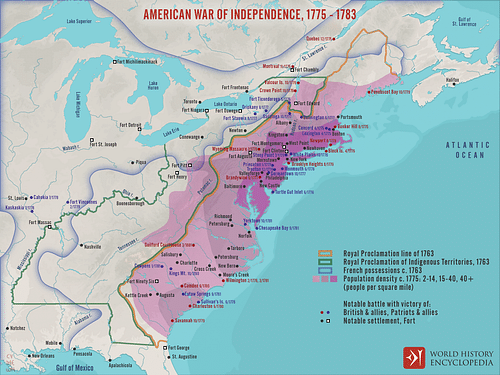
Recruitment of Enslaved Soldiers
During most of the colonial period in America, the institution of slavery was present in each of the thirteen British colonies. While many modern Americans associate the practice of chattel slavery primarily with the tobacco or cotton plantations of the American South, it was not uncommon for well-off northerners to own slaves as well. In Boston, for instance, one in five households owned at least one enslaved person, while as much as 20% of the population of the colonial Province of New York were enslaved. In the area around Rhode Island's Narragansett Bay, one in three people were enslaved, condemned to perpetually work the colony's dairy farms, or in one of the colony's other signature industries of lumbering, fishing, or manufacturing. Rhode Island had particularly strict punishments for those who aided runaway slaves, and even free Black and Indigenous people had difficulty finding fair wages for their work.
It was hardly surprising, then, that when the Revolutionary War erupted in April 1775, many non-white residents of New England saw an opportunity. After first blood was spilled at Lexington and Concord, as many as 15,000 New England militiamen descended on the British soldiers holed up in Boston; a good portion of these militiamen were Black or Indigenous, hoping to increase their social standings by helping to forge a new nation. When George Washington arrived to take command the following July, one of his first acts was to bar non-whites from enlisting in the Continental Army; as a Virginian slaveowner, Washington feared arming large numbers of slaves, who might one day turn those weapons on their masters. In fact, the question of whether to let free Black men, let alone slaves, fight in colonial militias was an ongoing matter of debate in several of the colonies' revolutionary governments. The British, who understood that the Americans lived in constant fear of slave revolts, saw an opportunity. In November 1775, Lord Dunmore, the royalist governor of Virginia, issued a proclamation promising freedom to any slave willing to take up arms for the Loyalist cause or otherwise hinder the American rebellion.
In the months that followed Lord Dunmore's proclamation, thousands of Black men from across the southern colonies flocked to his banner. Before long, there were more than enough Black men willing to fight for the British to form their own Loyalist regiment, known as Dunmore's Ethiopian Regiment. Commanded by white British or Loyalist officers, the Black soldiers of the Ethiopian Regiment were paid steady wages and, most importantly, freed. When the British occupied New York City in September 1776, there was likewise a great migration of New York slaves moving to Manhattan, where the Union Jack, not the Stars and Stripes, represented freedom.

To combat this, Continental officers were forced to turn a blind eye to Washington's decree and allow non-whites to join their regiments; if they refused, they risked having these men flock to the enemy. While most of these non-white recruits were free men, a number of enslaved men also joined the Continental ranks, though this was more often the case of a master offering up his slave to fight in his stead rather than a runaway slave enlisting on his own accord. By the time Washington retracted his ban on non-white soldiers in 1778, most Continental regiments already had at least one Black soldier. But the suggestion brought forth by General Varnum, of creating a primarily Black regiment, was still unheard of; believing it to be at least worth considering, Washington sent the idea along to the Rhode Island Assembly in early 1778, without offering his opinion one way or the other.
The Black Regiment
By 1778, the state of Rhode Island was having difficulty finding enough volunteers to fill the recruitment quotas placed on it by the Continental Congress; since at least 9% of the Rhode Island population was Black, the idea of establishing an all-Black (or at least majority-Black) regiment to help meet their quota was appealing. In February 1778, therefore, the Rhode Island Assembly proclaimed:
Every able-bodied Negro, Mulatto, or Indian slave man in this state may [enlist]…to serve during the continuance of the war with Great Britain; that every slave so enlisting shall be entitled to, and receive, all the bounties, wages, and encouragements allowed by the Continental Congress…that every slave enlisting shall…be absolutely FREE, as though he had never been incumbered with any kind of servitude or slavery. (Geake, 40)
Within weeks, 88 Rhode Island slaves had appeared before Colonel Christopher Greene to enlist in the 1st Rhode Island Regiment. The Assembly had promised to placate the enslavers by paying them the market value of each of their slaves that enlisted; however, enough slaveowners criticized the proclamation to force the Assembly to turn it into a temporary policy, valid only until the end of June. Still, this was enough time for scores of enslaved people to sign up. Ultimately, 140 of the 225 men in the 1st Rhode Island were Black, mixed race, or Native American. Black women also accompanied the regiment as camp followers, offering their services as wagon drivers, seamstresses, and maids while the men performed their soldierly duties. At first, the black and white soldiers of the regiment were kept in segregated companies; but once the regiment started taking casualties, and losses were compensated either by recruiting new troops or combining two depleted companies into one, each company became racially integrated.
The new soldiers of the 1st Rhode Island would not have to wait long to see action. The British had occupied Newport, Rhode Island since December 1776, and in the summer of 1778, a joint Franco-American expedition was planned to take it back: a French fleet would arrive off the coast to drop off troops, while the Americans besieged the city by land. On 10 August, just as the French fleet arrived off the coast of Newport, it was badly damaged in a storm and was forced to retreat to Boston to make repairs. Unwilling to attempt the operation alone, the American army was preparing to abandon their siege when it was attacked by British and Hessian forces on 29 August 1778 in what became known as the Battle of Rhode Island. The 1st Rhode Island, under the temporary command of Major Samuel Ward Jr, defended a hill on the American right flank, where they soon found themselves in the thick of the fighting as they covered the army's tactical retreat. Standing their ground behind a thicket, the 1st Rhode Island drove back three Hessian assaults, engaging in fierce hand-to-hand fighting. It was only after dark had fallen that the regiment was able to slip away. General John Sullivan, in overall command of the American forces at Newport, reported that the 1st Rhode Island had earned "a proper share of the honors of the day", while Marquis de Lafayette commented that it was some of the finest fighting he had seen during the war (Kaplan, 55).
Although the British retained control of Newport, the main theater of the war shifted to the south; since the 1st Rhode Island remained garrisoned in the north, it did not see any action for the next three years. On 14 May 1781, while the regiment was stationed near Pine's Bridge, New York, it was assaulted by a Loyalist militia under James De Lancey. The regiment was taken completely by surprise and Colonel Christopher Greene was killed, alongside one of his officers, Major Ebenezer Flagg; in describing Greene's death, William Cooper Nell records that "the sabers of the enemy only reached [Greene] through the bodies of his faithful guard of blacks, who hovered over him to protect him, every one of whom was killed" (Geake, 69). Indeed, eight Black soldiers also lost their lives in the attack, at least four of whom were former slaves.
Later that year, the 1st Rhode Island was sent to Virginia where it participated in the Siege of Yorktown (28 September to 19 October 1781), the last major engagement of the war. During the siege, the Americans' French allies became impressed with the soldiers of the 1st Rhode Island, with one French officer describing them as "the most neatly dressed, the best under arms, and the most precise in all their maneuvers" (Kaplan, 56). The 1st Rhode Island joined the American assault that captured the British redoubts, which helped lead to the surrender of Lord Charles Cornwallis' British army. Afterward, the 1st Rhode Island accompanied the Continental Army to Newburgh, New York, and then to Saratoga, where it remained until it was officially disbanded on 25 December 1783, after the Treaty of Paris had brought the American Revolutionary War to an end. It was one of the few military units to have existed for the entire duration of the war.
After the War
The Black soldiers who had served with the 1st Rhode Island were freed upon the regiment's disbandment, as promised, but few were offered any further relief. While their white comrades were guaranteed 100 acres of land and military pensions by Congress, many of the Black veterans were still owed back pay by the federal government for their wartime service. Many were subsequently forced to take low-paying work as laborers, sometimes on the very farms where they had been enslaved. In 1784, those African Americans who had served had to petition Congress for their payment; white officers such as Lieutenant Colonel Jeremiah Olney, who had taken command of the regiment after Greene's death, often had to go to court to verify that the Black men suing for back pay had indeed served in the regiment. In fact, Olney would spend the better part of the next decade advocating for the Black soldiers formerly under his command.

In February 1785, the Rhode Island Assembly finally addressed this issue, passing an act "for the support of the paupers, who heretofore were slaves, and enlisted into the Continental Battalions" (Geake, 93). The act required that any Black or Indigenous veteran who could not support himself be taken care of by the town in which he lived. The Rhode Island Assembly also passed an act that forbade any person born in the state after 1 March 1784 from being enslaved (this did not abolish slavery in Rhode Island, however, which would not officially occur until 1843). At the same meeting, Lieutenant Colonel Olney presented the regiment's colors to the Assembly, and they have been kept at the Rhode Island State House ever since. The 1st Rhode Island Regiment marks an important, though often-forgotten, chapter of the American Revolution. In a war fought in the name of liberty, these men fought for freedom from bondage and for their basic human rights, nearly a century before other Black regiments fought for the same cause in the American Civil War (1861-1865).



